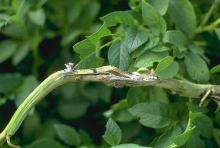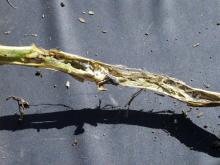By P. B. Hamm and C. M. Ocamb
Cause A fungus, Sclerotinia sclerotiorum, that overwinters in soil as hard black sclerotia. Sclerotia germinate in spring and produce small, inverted, mushroom-like structures called apothecia that shoot spores into potato foliage. Spores produced in the potato field are more important for infection then those from outside the field. Petals on flowering potato plants are especially susceptible and important in the disease cycle. Petals fall and naturally become associated with stems. Infected petals are an initial source of nutrient for the fungus, which then infects the stems. Spores can also infect the stem directly. Sclerotia also can germinate directly and infect the plant. Though widespread, and at times appearing to be quite damaging, due to the easily seen damage in the field, the effect of yield is likely marginal in most fields.
Symptoms First, vines in the field rapidly wilt and die due to the girdling canker on the stem. The infected area can become covered with white mycelium. The stem becomes a light brown to white and brittle after infection. Sclerotia commonly are inside these dried stems. At times, small inverted trumpet-shape structures called apothecia can be found under the vine cover after row closure, but because of their size, these are difficult to see.
Cultural control
- It may help to reduce humidity within the vines by increasing spacing, decreasing vine growth, and irrigating less frequently.
Chemical control The disease must be severe for fungicide application to be economically effective.
- Blocker 4 F (Group 14) at 3 to 5 pints/A on 10-day intervals. Foliar applications of Blocker 4F cannot be made if Blocker or other PCNB products were used in-furrow at planting; a maximum of two (2) foliar applications of Blocker 4F/A/year. Do not apply within 28 days of harvest. For use in Oregon, Washington, and Idaho only 12-hr reentry.
- Botran 5 F (Group 14) at 1.2 to 3.6 quarts/A. Begin treatment at first flower drop, or at approximately the time of full bloom of primary flower inflorescences. If disease persists, subsequent applications may be made at 7- to 10-day intervals. Chemigation is the preferred method of application. Do not apply within 20 days of harvest. 12-hr reentry. Apply with the following equipment:
- Sprinkler irrigation-See "Application through Sprinkler Irrigation Equipment" for specific instructions.
- Ground equipment-In Oregon and Idaho, apply as a directed spray to the base of plants and adjacent soil surface using drop nozzles. Use at least 30 gal/A water. Do not spray upper canopy of foliage as this may cause minor leaf bronzing. If canopy is to be sprayed, use at least 100 gal/A water. For use in Washington, see label for specific details.
- Endura (Group 7) at 5.5 to 10 oz/A at full bloom of primary flower inflorescences. Make a second application 14 days later if conditions continue to be favorable for disease development. Preharvest interval is 10 days. 12-hr reentry.
- Formulations of iprodione (Group 2) are labeled.
- Rovral 4 Flowable at 2 pints/A in at least 10 gal/A water. Do not apply by air for white mold control. Apply at first sign of disease or at full bloom of primary flower inflorescences and again 14 to 21 days later. (These applications also control early blight). Do not irrigate for 24 hours after application. Do not apply within 14 days of harvest. 24-hr reentry.
- Miravis Prime (Group 7 + 12) at 11.4 fl oz/A at or before row closure followed by a second application 14 days later. Do not make more than two (2) sequential applications. Preharvest interval is 14 days. 12-hr reentry.
- Omega 500 F (Group 29) at 5.5 to 8 fl oz/A on 7- to 10-day intervals beginning at row closure or when flowers begin to fall. Do not apply within 14 days of harvest. 12-hr reentry.
- OSO 5% SC (Group 19) at 3.75 to 13 fl oz/A on 7- to 14-day intervals. Can be applied the day of harvest. 4-hr reentry. O
- Formulations of thiophanate-methyl (Group 1) are registered.
- T-Methyl 4.5F AG at 20 to 30 fl oz/A. Make first application at full bloom of primary flower inflorescences and repeat on 7- to 14-day intervals. Preharvest interval is 21 days. 12-hr reentry.
- Topsin M WSB at 1 to 1.5 lb/A on 7- to 14-day intervals. Make first application at full bloom of primary flower inflorescences. Do not apply within 21 days of harvest. Aerial application is not recommended for control of this disease on this crop. 2-day reentry.
Biological control Efficacy unknown in Oregon.
- Bexfond at 7 to 14 fl oz/A. 4-hr reentry. O
- Double Nickel LC at 1 to 6 quarts/A on 3- to 10-day intervals. Can be applied the day of harvest. 4-hr reentry. O
- LifeGard WG at 1 to 4.5 oz/100 gal on 7- to 14-day intervals for activating plant resistance. Apply in alternating, or tank-mix program, with compatible, labeled fungicides as part of a disease management program. Refer to label for appropriate rate per application volume. Preharvest interval is 0 days. 4-hr reentry. O
- Serenade Opti at 14 to 20 oz/A on 7- to 10-day intervals. Applications can be made up to and the day of harvest. 4-hr reentry. O
- Stargus at 2 to 4 quarts/A plus a nonionic surfactant on 7- to 10-day intervals. Preharvest interval is 0 days. 4-hr reentry. O
Reference Johnson, D.A., and Atallah, Z.K. 2006. Timing fungicide applications for managing sclerotinia stem rot of potato. Plant Disease 90:755-758.


